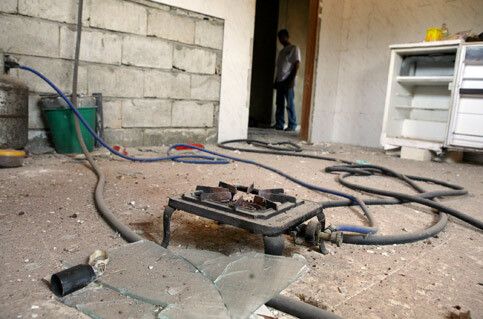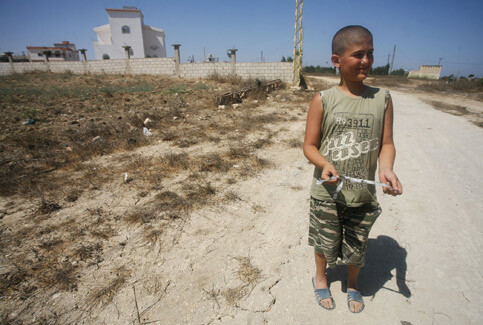south Lebanon 30 October 2006

An American-made M42 cluster bomb in a Lebanese citizen’s kitchen (MACCSL)
It is estimated that Israeli bombings of Lebanon left more than a million unexploded cluster bombs and anti-personnel weapons. Few lie around in Yasmine’s garden. Yasmine is 11 years old, from a small village in the south of Lebanon and a good tour guide around her family’s garden as she shows you the remaining unexploded cluster bombs. Two to give a count — one is hiding high in the grape vine and the other next to a little rock. They look nonthreatening, just little odd metal canisters calling to be removed. But Yasmine is good at protecting you. She firmly asks you not to touch them nor get close to them, only to laugh later as she teases you that you can never know when the one on the grape vine would fall, “so you’d better be ready to run”. She says, “sometimes brown vine leaves fall and we would run thinking it is the bomb … it is very scary. But after we run and hide and notice it is just a vine leave we laugh a lot. Only God knows when will it fall. I hope it falls when we are out on a visit, this way it will explode and we will get rid of it without getting hurt.”
Everybody speaks of the cluster bombs in the south. Ask anyone and you will get stories of where they were found, or how someone died or got amputated as a result of one. A daily fear that we are living with these days turned into a nightmare with the begining of the rain season - rainwater covering the bomblets with mud. Rain can smoothly push some bombs under rocks, can pat the grass on top of others and even bury it totally with mud. The rain started, and so did the nightmare. It is you and your luck with your life in your hand for years to come. So walk, move, touch and look carefully … it can be anywhere, and one tiny mistake is fatal.
The summer is towards its end and many harvests are getting due while some already are. These harvests of olive, tobacco, wheat or fruits that supply the farmer with a considerable annual income are being wasted to rot. Fields are feared to have cluster bombs, and many do. People are kept away from their gardens and the look on their faces helplessly watching their crops wither and rot in is unforgettable. “There isn’t a bigger crime. Haram [it’s a shame]. Everything is rotting and we cannot harvest it,” Abu-Ahmad tells me as he sits on his balcony smoking his water-pipe and watching his field. “We are done away with for the year to come as well, it is running late to plant the winter crop. It is a disaster, how will we manage through winter? and even after that. All we can do is sit and watch it all die and our land go bare.” The agricultural communities in the south suffered serious blows and devastating damage for the infrastructure, machinery and harvest. Those with cluster bombs in their fields are expected to still be suffering economically the year to come even if the bombs were totally removed. The winter harvest will not see the light; there is no way of seeding or planting with cluster bombs all over.
Over a hundred civilian casualties since the cease-fire thanks to the unexploded cluster bomblets. According to Handicap International, an estimated three civilians daily fall victims to unexploded clusters — a nightmare that is not exclusively Lebanese. Lebanon is not the first terrain where cluster bombs were used; they have been used in Vietnam, Afghanistan, Iraq, Western Sahara, Kosovo, Sierra Leon, Chechnya, Cambodia … and the list goes on. It is estimated that around 300 people still die in Vietnam each year as a result of cluster bombs and other US army leftovers. It is likely that a child who was not born at the time of the bombing would die from a still-unexploded cluster bomb. Israel has been using cluster bombs in Lebanon since 1978 and people continue to suffer from them till today. Only now we have few hundred thousand more to watch out from, or simply blow us to pieces.

A Lebanese child plays with a cluster bomb ribbon (MACCSL)
“Popcorn”
“Popcorn” is the US military slang name for cluster bombs. An apt yet brutal parody. The basic design of cluster bombs is a hollow shell hosting hundreds of “small bomblets” varying according to model and design. These little bomblets are scattered over with a possible affected area getting as wide as three football fields. Cluster bombs are known to have a high rate of leaving unexploded bombs behind - still they are in use. Absurdly enough, some manufacturers of these bombs decided to give them bright colors in an alleged attempt to undermine their risk by making the leftovers more visible to civilians. Not surprisingly, it turns out that the newly introduced bright colors are only worsening the situation because they are attractive children. A nightmare well-known to Afghani and Vietnamese children to name a few, let alone to the governments of the world. Still, cluster bombs are among the “legitimate” weapons.
Israel admitted dumping more than 1,800 cluster bombs over Lebanon carrying more than 1.2 million bomblets - noting that Israel, like any state, plays down the number of bombs it uses. Still, 1.2 million bomblets are hellish enough. According to United Nations estimates, 40 percent of the cluster bombs thrown by Israel during the recent war on Lebanon are unexploded — you do the calculation. Jan Egeland, UN undersecretary-general for Humanitarian Affairs and Emergency Relief Coordinator, stated that “what’s shocking and I would say completely immoral is that 90 percent of the cluster bomb strikes occurred in the last 72 hours of the conflict when we knew there would be a resolution, when we knew there would be an end.” An Israeli reservist quoted in the Israeli newspaper Haaretz on the 8th of September 2006 said, “In the last 72 hours we fired all the munitions we had, all at the same spot, we didn’t even alter the direction of the gun. Friends of mine in the battalion told me they also fired everything in the last three days - ordinary shells, clusters, whatever they had.”
International bodies such as the Red Cross and Human Rights Watch have serious criticism and opposition to the usage of these bombs. Handicap International embarked in 2005 on an international campaign to ban these weapons, yet Belgium is the only state that has banned cluster bombs.
Recently Human Rights Watch issued concern over Hezbollah’s usage of cluster bombs for the first time during the recent Israeli war on Lebanon. It is stupid to use this as a justification for Israeli crimes. The spread of these bombs is rather another case for supporting a world ban on them, and holding all users accountable.
The alarm is urgently sounding in Lebanon; it has been for a long time. Many organizations are working on clearing cluster bombs in the south of Lebanon, and dealing with the consequences. This is not the solution as no one can guarantee total cleaning of the bombs. Banning them is a step towards one, and definitely holding those who use them accountable, not only of the crimes committed, but also of cleaning them and dealing with the consequences.
People suffering from amputations and life losses as a result of unexploded cluster bombs cannot recuperate what they lost. Who would deal with this? Their families and their loved ones, let alone them themselves. War does not end in their lives, it lives on while the rest of the world prepares for another war, another cluster.
Imad Mortada is a Lebanese anarchist queer activist and Indymedia volunteer based in Barcelona.
Related Links


